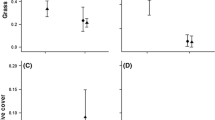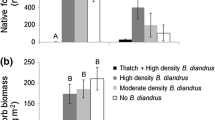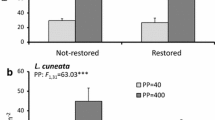Abstract
I measured competitive responses of experimentally-established populations of the perennial grass, Andropogon gerardi, across a complex gradient of standing crop and species composition in the successional grasslands of southwest Michigan. The goal was to assess whether long-term (three year) population-level responses of Andropogon to competition matched the inferences made from a previous phytometer study that examined transplant responses to competition across this same gradient over a single growing season.
Replicate experimental populations of Andropogon were established at seven grassland sites by sowing seed into 0.5×0.5 m plots that had been denuded of all vegetation. During the first year of the study, all Andropogon populations were maintained as monocultures by hand weeding. At the end of the first growing season, half of the monocultures were selected for continued weeding and half were left open to invasion by competitors for three years. Invasion of the unweeded populations by neighboring plants varied strongly among sites and was positively correlated with standing crop. Increased susceptibility to invasion and competition resulted in the extinction of the unweeded Andropogon populations at the two most productive sites, supporting the hypothesis that Andropogon is restricted by competition to low productivity sites in these grasslands. The finding that the intensity of competition was positively correlated with standing crop is consistent with the previous transplant study, suggesting that short-term experimental assays of competition on the growth of individual transplants may have predictive value for longer-term outcomes of competition at the population level.
Similar content being viewed by others
References
Bazzaz, F. A. & Parrish, J. A. D. 1982. Organization of grassland communities. Pp. 233–254. In: Estes, J. R. (ed.), Grasses and grassland communities. Oklahoma State University Press, Stillwater, Oklahoma.
Bonser, S. P. & Reader, R. J. 1995. Plant competition and herbivory in relation to vegetation biomass. Ecology 76: 2176–2183.
Burbank, D., Pregitzer, K. S. & Gross, K. L. 1992. Vegetation of the W. K. Kellogg Biological Station. Michigan State University Agricultural Experiment Station Research Report Number 501.
Foster, B. L. 1999. Establishment, competition and the distribution of native grasses. J. Ecol. 87: 476–489.
Foster, B. L. & Gross, K. L. 1997. Partitioning the effects of plant biomass and litter on Andropogon gerardi in old-field vegetation. Ecology 78: 2091–2104.
Gleason, H. A. & Cronquist, A. 1991. Manual of vascular plants of northeastern United States and adjacent Canada. New York Botanical Garden, New York.
Goldberg, D. E. 1990. Components of resource competition in plant communities. Pp. 27–49. In: Grace, J. B. & Tilman D. (eds), Perspectives on plant competition. Academic Press, New York.
Goldberg, D. E. & Barton, A. M. 1992. Patterns and consequences of interspecific competition in natural communities: a review of field experiments with plants. Am. Nat. 139: 771–801.
Gotshall, T. B. 1972. The vegetation of Kalamazoo County at the time of settlement. Pp. 1–21. In: Brewer, R. (ed.), The Ecology of Kalamazoo County. Western Michigan University Press, Kalamazoo, Michigan.
Grace, J. B. 1990. On the relationship between plant traits and competitive ability. Pp. 51–65. In: Grace, J. B. & Tilman D. (eds), Perspectives on plant competition. Academic Press, New York.
Grime, J. P. 1973. Competitive exclusion in herbaceous vegetation. Nature 242: 344–347.
Grime, J. P. 1979. Plant strategies and vegetation processes. J. Wiley & Sons, Chichester.
Grubb, P. J.1977. The maintenance of species-richness in plant communities: the importance of the regeneration niche. Biol. Rev. 52: 107–145.
Gurevitch, J., Morrow, L. L., Wallace, A. & Walsh, J. S. 1992. A meta-analysis of competition in field experiments. Am. Nat. 140: 539–572.
Huston, M. A. 1979. A general hypothesis of species diversity. Am. Nat. 113: 81–101.
Kadmon, R. 1995. Plant competition along soil moisture gradients: a field experiment with the desert annual Stipa capensis. J. Ecol. 83: 253–262.
Keddy, P. A. 1989. Competition. Chapman and Hall, London.
Newman, E. I. 1973. Competition and diversity in herbaceous vegetation. Nature 244: 310.
Peltzer, D. A., Wilson, S. D. & Gerry, A. K. 1998. Competition intensity along a productivity gradient in a low-diversity grassland. Am. Nat. 151: 465–476.
Shipley, B., Keddy, P. A. & Lefkovitch, L. P. 1991. Mechanisms producing plant zonation along a water depth gradient: a comparison with the exposure gradient. Can. J. Bot. 69: 1420–1424.
Southwood, T. R. E. 1988. Tactics, strategies, and templates. Oikos 52: 3–18.
Tilman. D. 1988. Plant strategies and the dynamics and structure of plant communities. Princeton University Press, Princeton, New Jersey, USA.
Twolan-Strutt, L. & Keddy, P. A. 1996. Above-and belowground competition intensity in two contrasting wetland plant communities. Ecology 77: 259–270.
Waller, S. S. & Lewis, J. K. 1979. Occurrence of C3 and C4 photosynthetic pathways in North American Grasses. J. Range Manag. 32: 12–28.
Wedin, D. & Tilman, D. 1993. Competition among grasses along a nitrogen gradient: initial conditions and mechanisms of competition. Ecology 63: 199–229.
Wilkinson, L. 1989. SYSTAT: the system for statistics. SYSTAT, Evanston, Illinois.
Wilson, S. D. & Keddy, P. A. 1986. Measuring diffuse competition along an environmental gradient: results from a shoreline plant community. Am. Nat. 127: 862–869.
Wilson, S. D. & Tilman, D. 1991. Components of plant competition along an experimental gradient of nitrogen availability. Ecology 72: 1050–1065.
Wilson, S. D. & Tilman, D. 1993. Plant competition in relation to disturbance, fertility and resource availability. Ecology 74: 599–611.
Zar, I. H. 1996. Biostatistical analysis. Prentice-Hall, Englewood Cliffs, New Jersey, USA.
Rights and permissions
About this article
Cite this article
Foster, B.L. Competition at the population level along a standing crop gradient: a field experiment in successional grassland. Plant Ecology 151, 171–180 (2000). https://doi.org/10.1023/A:1026569432257
Issue Date:
DOI: https://doi.org/10.1023/A:1026569432257




